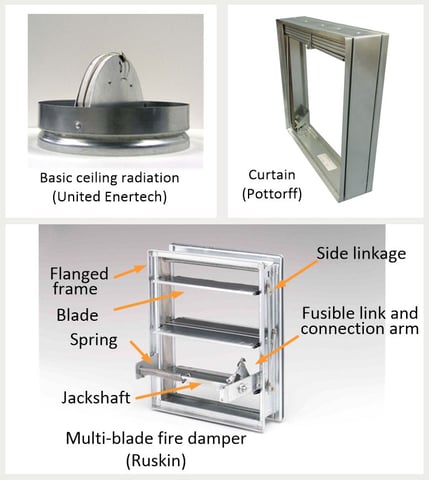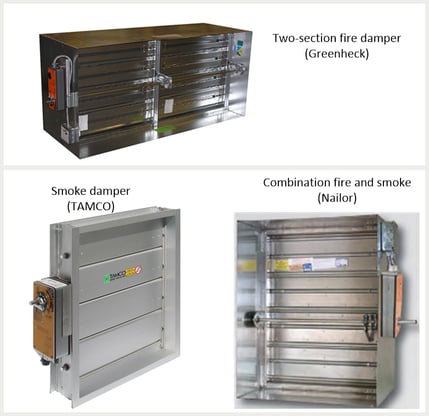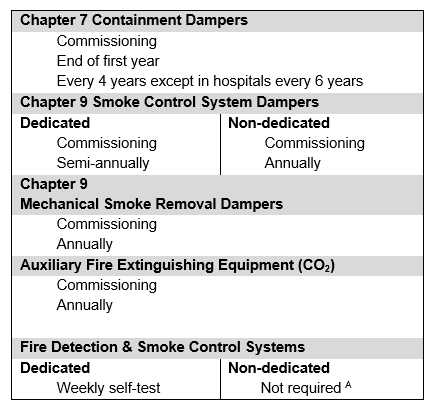Code Required Testing of Life Safety Dampers
Building codes require the installation of life safety dampers for several purposes. Most are used to prevent the spread of heat, fire, and/or smoke in a life-threatening event. There are four essential types of life safety dampers:
1) Ceiling radiation
2) Fire
3) Smoke
4) Combination fire and smoke
Three general applications:
1) Compartmentation to prevent heat, fire or smoke transfer across barriers
2) Smoke control systems to prevent smoke movement within spaces or exhaust to the outside
3) Fire extinguishing or evacuation systems
Depending on the application, they have varying requirements for periodic testing. Figure 1 shows a ceiling damper used to prevent heat transfer, a curtain damper, and a multi-blade fire damper. Figure 2 shows actuated life safety dampers.
 Figure 1 Non-actuated heat and fire dampers
Figure 1 Non-actuated heat and fire dampers

Figure 2 Actuated fire, smoke, and combination dampers
Codes and referenced standards
The International Fire Code (IFC) defines the requirements for periodic testing of dampers. It references NFPA 80 (fire) and NFPA 105 (smoke) requirements in Section 706.1 Maintaining Protection.
Dampers installed per Chapter 7 of the IBC are part of fire-resistance-rated construction. Dampers installed per Chapter 9 are smoke control system dampers.
The building owner is responsible for maintaining fire resistance rated construction. This is firmly stated in IFC Section 701.6 Owner’s Responsibility and repeated in Section 907.8.5 Inspection, Testing, and Maintenance. The owner is responsible for maintaining records of inspections and repairs, which is stated in NFPA 80 and NFPA 10 specific to dampers. The authority having jurisdiction may require copies of invoices, a log book, or other maintenance reports for examination during inspections.
It is not stated the qualification for testing requirements in the IFC or IBC. Building stationary engineers, TAB contractors, or professional engineers can be involved. This is in contrast to initial commissioning where in both codes’ Section 909.3 Special Inspection and Test Requirements, commissioning of a smoke control system is required to be performed by qualified professionals. IBC Section 1704 references professional qualifications and record keeping requirements. IBC Section 1705.18.2 establishes that smoke control testing (commissioning) agents “shall have expertise in fire protection, engineering, mechanical engineering and certification as air balancers.” IFC Section 909.18.8.2 Qualifications restates the requirement.
Some of the larger owners and hospitals have qualified people on staff to perform the testing. Others ignore the requirements or are not aware they exist. Service contracts need to include periodic testing either by the ventilation or mechanical contractor or by hiring a sub-contractor. Local code officials should be consulted for requirements and service contracts include damper and all code required testing.
Testing Requirements
IBC Section 706.1 Maintaining Protection states that dampers protecting openings shall be maintained in accordance with NFPA 80 and NFPA 105. IFC and IBC Section 909.12 Detection and Control Systems, requires UL 864 and UUKL listing for all smoke controls and associated equipment. A weekly self-test is required. Actuated dampers are not investigated to UL 864 standards they can be excluded from the weekly self-test as long as the fire code official approves. Dampers are investigated to one of the UL 555 family of standards. An exception to 909.12.1 allows components that interfere with building operation to be bypassed in testing and that Section 909.20.6 of the IFC be followed.
The most common situation where dampers are not tested is at the intakes or outlets of fans. If the fan is running and a damper closes, negative duct pressure (suction) or positive pressure (discharge) can collapse ducts or split the seams and the fans may shut-down on static pressure limits, which are usually manually reset. As the smoke control fans and dampers are typically part of the fire alarm equipment and non-dedicated equipment of the building management system, care must be taken to avoid interference and damage.
IFC Section 909.20 is in regards to maintenance; Sections 909.20.1 through 909.20.6 details the requirements. Operational testing of each control sequence and device must be tested semi-annually for dedicated systems. Non-dedicated systems must be tested annually. Dampers are specifically included in Section 909.20.3. Section 909.20.6 Components Bypassing Weekly Test requires semiannual testing. Dedicated system dampers must be tested semi-annually per NFPA 105. Non-dedicated dampers must be tested annually, since they are not UL 864 listed. The NFPA standard regulates the testing frequency. However, the authority having jurisdiction can require testing in cases where appropriate.
Other dampers that need testing may be installed per IBC 909.20 Smokeproof Enclosures. They should be tested per smoke control system damper requirements.
Section 904.8.5 Auxiliary Equipment, (fire extinguishing) the requirement exists for components, including dampers to be operated at “12-month intervals.” Carbon dioxide systems are covered in Section 904.12.3. It recognizes that dampers may be installed in a duct as part of the system. Section 904.8.1 System Test requires yearly inspection and testing. As with all systems, records must be maintained.
IFC Section 910.5.2 requires that mechanical smoke removal equipment should be tested and maintained according to NFPA 204 and manufacturer’s instructions. These systems should be inspected and tested annually, and all ancillary equipment should be included. This would include any associated fan discharge dampers. A record must be kept. These dampers are not typically considered to be smoke control related but in specific cases may be interpreted as. Table 1 provides a summary of what we just covered.
Table 1
 A Subject to the Exception in 909.12.1
A Subject to the Exception in 909.12.1
There are four essential types of life safety dampers, all have varying requirements for periodic testing except for ceiling radiation dampers. Fire and combination dampers used for containment per Chapter 7 of the codes require testing every four years except in hospitals, every six years. Smoke and combination dampers used in dedicated smoke control systems require testing twice a year while those in non-dedicated systems require testing once a year. Other dampers used in fire protection or smoke evacuation require testing every year. It is the building owner who is responsible for testing.  About the Author
About the Author
Larry Felker is the Fire and Smoke Product Manager for Belimo Americas. He is Vice Chair of the Air Movement and Control Association (AMCA) International’s Fire and Smoke Damper Task Force, and is an active member in the International Code Council, the National Fire Protection Association, Society of Fire Protection Engineers, and a life member of ASHRAE. He is co-author of the book “Dampers and Airflow Control” published by ASHRAE Special Publications in 2010.
i. International Fire Code 2018, International Code Council, Inc. (ICC), Country Club Hills, IL 60478
ii. NFPA 80 Standard for Fire Doors and Other Opening Protectives, 2016 Edition, National Fire Protection Association, 1 Batterymarch Park, Quincy, MA 02169-7471
iii. NFPA 105 Standard for the Installation of Smoke Door Assemblies and Other Opening Protectives, 2016 Edition, ibid.
iv. International Building Code, ICC, op.cit.
v. UL 864 Standard for Safety Control Units and Accessories for Fire Alarm Systems, 10th Edition, 2018, Underwriters Laboratories Inc. (UL), 333 Pfingsten Road, Northbrook, IL 60062-2096. UUKL is a list of smoke control approved components and systems within UL 864.
vi. https://ulstandards.ul.com/access-standards/, ibid. Also see IBC 717.3 Damper testing, ratings and actuation.
vii. NFPA 204: Standard for Smoke and Heat Venting, 2018, op. cit.

